Timeline: The Middle East conflict
A timeline of important events in the Middle East conflict since the first world war.
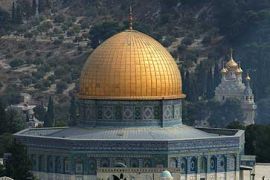
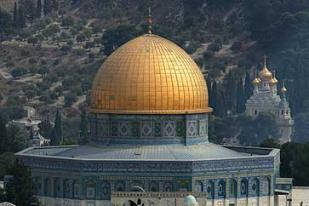 |
|
The Dome of the Rock lies at the heart |
1915-1916: Hussein-McMahon correspondence. Exchange of letters between Hussein ibn Ali, sharif of Mecca, and Sir Henry McMahon, British high commissioner in Egypt, regarding the future political status of the Arab lands of the Middle East.
Britain offered Arabs across the Middle East self-rule in exchange for their aid in defeating the Ottoman empire during the first world war.
1916, May 16: Sykes-Picot Agreement. Britain and France sign a secret pact outlining their spheres of control in the Middle East after the first world war. Palestine is designated for international administration pending consultations with Russia and other powers. The agreement is seen by Arabs as a betrayal of the Hussein-McMahon correspondence.
1917, November 2: Balfour Declaration. Arthur James Balfour, Britain’s foreign secretary, sends a letter to Lord Rothschild, president of the Zionist federation, stating the government’s support for the establishment of “a national home for the Jewish people” in Palestine, the area consisting of today’s Israel, the West Bank, Gaza Strip and Jordan.
The declaration reads: “His Majesty’s Government view with favour the establishment in Palestine of a national home for the Jewish people, and will use their best endeavours to facilitate the achievement of this object, it being clearly understood that nothing shall be done which may prejudice the civil and religious rights of existing non-Jewish communities in Palestine, or the rights and political status enjoyed by Jews in any other country.”
1922, July 24: The League of Nations gives Britain a mandate to administer Palestine. Britain expresses an interest in Zionism, and describes its intention to develop a Jewish state.
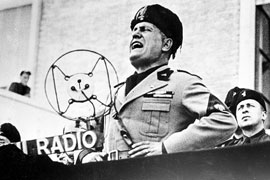
The rise of fascism in Europe led large
numbers of Jews to flee to Palestine
1929
–1939: In large part because of the rise of fascism in Europe, about 250,000 Jews arrive in Palestine during this period.

The rise of fascism in Europe led large
numbers of Jews to flee to Palestine
1929, summer: Arguments between Muslims and Jews over access to the Western Wall. More than 130 Jews are killed and 339 wounded and 116 Arabs killed and 232 wounded during clashes involving British forces.
1929, August 23: Hebron massacre: After hearing rumours of killings of Arabs in Jerusalem, rioters kill 67 Jews in Hebron. Many Jews survive by sheltering with Arab neighbours, and after the riots, the remainder of the Jewish population is evacuated by the British.
1930-35: Violent activities of Black Hand Islamist group led by Sheikh Izz al-Din al-Qassam against Jewish civilians and the British.
1936-39: Arab revolt to protest against Jewish immigration to Palestine led by Haj Amin al-Husseini. More than 5,000 Arabs are killed, mostly by the British. Several hundred Jews are killed by Arabs.
1946, July 22: Bombing of the King David Hotel in Jerusalem, which housed the British civil, military and police command in Palestine, by the Irgun, a Zionist organisation. A total of 91 people are killed: 28 British, 41 Arab, 17 Jewish and five from other countries.
1947, November 29: United Nations General Assembly passes a partition plan dividing the British Mandate of Palestine into two states. Accepted by the Jewish leadership but rejected by the Arab leadership.
1947-1949: The Nakba, meaning “disaster” or “cataclysm” in Arabic. Up to 900,000 Palestinians flee or are expelled from their homes in the part of the land that becomes the state of Israel.
1948, April 9, 11: Deir Yassin massacre. Between 100 and 254 Palestinian villagers, mainly women, old people and children are killed during and after an attack on the village of Deir Yassin near Jerusalem by Irgun members.
1948, May 15: Declaration of Israel as the Jewish state. British withdraw from Palestine. Arab-Israeli war. Egypt, Syria, Jordan, Saudi Arabia, Iraq and Lebanon declare war on Israel. Egypt, Jordan and Syria invade Israel.
1949, April: Israel and Arab states agree an armistice. Israel takes about 50 per cent more land than was originally allotted to it by the UN partition plan.
1956: Egypt nationalises Suez Canal (July 26). France, Britain and Israel plan invasion of Egypt. Israel invades the Sinai peninsula (October 29). Pressure from the US and USSR force France, Britain and Israel to withdraw.
1964, May: The Palestine Liberation Organisation (PLO) is founded in Cairo by the Arab League. The PLO states its goal as the destruction of the Israel through armed struggle, and the restoration of an “independent Palestinian state” between the Jordan river and the Mediterranean sea.
1967, June: Third Arab-Israeli war (Six-Day War). Israel launches a pre-emptive attack on Egypt, Syria and Jordan. Israel captures Sinai Peninsula and Gaza Strip from Egypt, the Golan Heights from Syria and the West Bank and East Jerusalem from Jordan.
1967: Israel begins settlement programme in areas captured during the Six-Day war.
1967, November 22: UN Security Council passes resolution 242, which calls for Israel to withdraw its armed forces from all territories occupied since the 1967 Arab-Israeli war. The resolution affirms the right of all states in the region to “live in peace within secure and recognised boundaries”.
1968-1970: War of Attrition. Limited war fought between Egypt and Israel in which Egypt attempts to regain the Sinai Peninsula lost in the Six Day war. The war ended with a ceasefire in August 1970 with the same frontiers as at the start.
1969, February 2: Yasser Arafat is appointed chairman of the PLO.
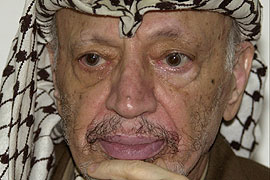 |
|
Yasser Arafat led the Palestine Liberation Organisation for 25 years |
1972, September 5: Eleven members of the Israeli Olympic team and one German police officer are killed by Palestinian group Black September at the Munich Olympics.
1973, October 6: Fourth Arab-Israeli war (October war). In a surprise attack on the Jewish Day of Atonement, Egypt and Syria retake the areas in Sinai and the Golan Heights that were lost in the Six Day war. Despite initial gains they are soon forced to retreat by Israeli forces.
1973, October 22: UN Security Council passes resolution 338, which calls for a ceasefire in the on-going war between Israeli and the Arab coalition.
1978, September 17: Menachem Begin, Israel’s prime minister, and Anwar Sadat, Egypt’s president, sign the Camp David Accord, with Israel agreeing to withdraw from the Sinai Peninsula in exchange for peace and a framework for future negotiation over the West Bank and Gaza Strip.
1979, March 26: Peace deal between Egypt and Israel. Egypt becomes the first Arab country to recognise Israel.
1979: Arab League suspends Egypt’s membership of the league following Egypt’s peace agreement with Israel. The organisation moves its headquarters to Tunis.
1981, October 6: Sadat is assassinated by members of the Egyptian Islamic Jihad organisation, while reviewing a military parade, in retaliation for Sadat’s recognition of Israel.
1982, June 6: Israel invades Lebanon to remove PLO fighters who it claims are threatening its border.
1982: PLO relocates to Tunis as it is driven out of Lebanon by Israel during the six-month invasion of the country. It remains active in Lebanon but not to the same extent as before 1982.
1982, September: Sabra and Shatila massacre. Lebanese Phalangists (members of a Christian para-military group) kill up to 2,750 Palestinians in the Palestinian refugee camps of Sabra and Shatila.
1983, August: The Israeli army withdraws from most of Lebanon, maintaining a self-proclaimed “security zone” in the south.
1985, October 1: Israel’s Operation Wooden Leg attempts to kill Arafat with an air raid on his headquarters in Tunis. He survives, but 60 members of the PLO are killed including much of the leadership.
1987, December 8: First intifada (uprising) starts. Palestinians begin general strikes, riots and civil disobedience campaigns across the West Bank and Gaza Strip. Israeli army replies with tear gas, plastic bullets, and live rounds. Sheikh Ahmed Yassin creates Hamas from the Gaza wing of the Egyptian Muslim Brotherhood.
1988, November 15: The Palestinian National Council, meeting in Algiers, unilaterally proclaims a State of Palestine.
1990, August 2: Iraq invades Kuwait, prompting UN sanctions. An international coalition force launch and air and ground assault against Iraq in January 1991. Iraq launches missiles in Iraq and Saudi Arabia during the fighting. The war ends on February 28, 1991 with a decisive victory for the international coalition.
1991, October: Middle East peace conference opens in Madrid, attended by Israeli, Syrian, Lebanese, Jordanian and Palestinian delegations. The conference opens dialogues on Arab-Israeli and Israeli-Palestinian relations.
1993, September 13: Oslo declaration of principles. PLO and Israel agree to recognise each other.
1994, February 25: Baruch Goldstein, an American-Israeli settler, enters Al-Haram Al-Ibrahimi (The Cave of the Patriarchs), a religious site in Hebron, and kills 29 Palestinians, injuring another 125.
1995, September 28: Interim agreement on the future of Israeli-occupied Gaza and the West Bank is signed by Israel and the PLO. The agreement recognises the formation of a Palestinian Interim Self-Government Authority – an elected council.
1994, October 26: Israel and Jordan sign a peace treaty ending 45-years of hostility. Israel agrees to recognise the special role of Jordan over Muslim holy sites in Jerusalem.
1995, November 4: Yitzhak Rabin, Israel’s prime minister, is assassinated by Yigal Amir, an Israeli orthodox Jewish student who is against the Middle East peace plan. Shimon Peres takes over as prime minister.
1998, October 23: Wye River Memorandum is negotiated between Israel and the Palestinian Authority to implement the 1995 interim agreement. The memorandum examines redeployment of Israeli troops from areas occupied since 1967 and Palestinian guarantees on security.
2000, July: The Camp David summit between Ehud Barak, Israel’s prime minister, Yasser Arafat, leader of the Palestinian Authority, and President Bill Clinton. Aimed at reaching a “final status” agreement the talks break down after two weeks and the US and the Israelis blame Arafat for refusing to accept a proposal drafted by their negotiators.
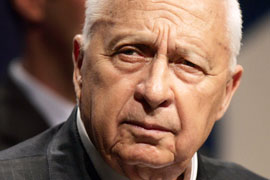 |
|
Ariel Sharon was elected leader of the Likud party on February 6, 2001 |
2000, September: Palestinians riot after Ariel Sharon, of the Likud party in Israel, visits the Temple Mount (the Noble Sanctuary) in Jerusalem. Second intifada begins.
2001, January: Summit between Israel and Palestinian Authority is held at Egyptian resort of Taba. The talks are designed to lead to ‘final status’ agreements on refugees, territory, security and Jerusalem. Differences remained between Israel and the Palestinians despite the discussions.
2001, February 6: Sharon is elected the leader of Likud and refuses to continue negotiations with Arafat.
2001, June 1: A Hamas suicide bomber attacks an Israeli nightclub. Twenty-one Israelis killed, mainly teenagers, more than 100 injured.
2001, October 17: Rehavam Zeevi, Israel’s tourism minister, is shot dead in Jerusalem by members of the Popular Front for the Liberation of Palestine.
2001, December: Sharon sends troops into Ramallah, shelling and surrounding the Palestinian government’s West Bank headquarters; Arafat is unable to leave.